The Other Air-Cooled Chevy
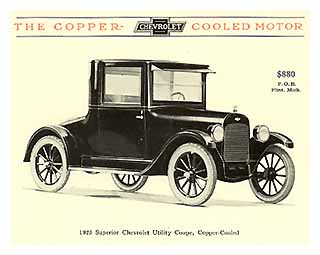
"...the whole car will work very sweetly and will continue to do so with only a very small fraction of the attention that would be absolutely necessary for the care of a horse." -Instruction Book for Chevy Copper-Cooled Motor Cars, 1923, p. 19.
We all know what makes Corvairs unique among American cars of the 1960's: Fully independent suspension, rear, horizontally-opposed air-cooled engine and so on. Many Corvair owners also know that the prewar Franklin cars were also air-cooled. Few, however, probably know of another, closer relative to our favorite car: The Copper Cooled Chevrolet of 1923. It was, in fact, air cooled just as the Corvair is and was named to avoid confusion with the Franklin.
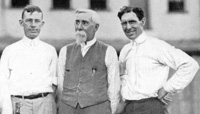
|
| L-R: W.A. Chryst, Chief Engineer of Delco, Henry Leland, President of Cadillac and Charles Kettering |
In 1916 he founded the Domestic Engineering Company division of DELCO to produce the DELCO-Light generator set--a small air-cooled engine turning a DC generator which supplied electrical power and charged its own starting battery. He sold a bunch of these--my great-grandfather had one on his farm in North Carolina.
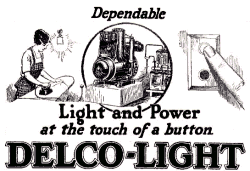
|
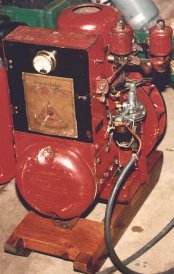
|
| Canadian DELCO-Light Advertisement from the 1920s | Picture of a Typical DELCO-Light. Note large centrifugal fan on crank that pulled air from top of engine |
In his work on the Delco-Light generator, Kettering found that eliminating the water jacket and radiator removed the most failure-prone components of the system and also reduced weight. His luck with making the DELCO generator sets air-cooled encouraged him to try the idea in a car.
First he did basic research on air flow over metal surfaces, heat transmission from metal to air, etc. The results and the economics of the time led him to decide on a predominantly cast-iron engine with copper fins on the cylinders. Today aluminum is the first choice, but in the 1920s, aluminum was still prohibitively expensive for large assemblies and was hard to cast. Copper transfers heat very well, is easy to work, was cheap at the time and could (he thought) readily be attached to cast iron by electric welding.
The next step was to decide just how the cylinders should be cooled. He experimented with different finning patterns, discarding the Corvair system in favor of straight, radial fins both for evenness of cooling and ease of manufacture. He then had to design a system to produce the fins, and found that a strip of copper sheeting bent into a long, thin loop could be oven brazed onto the cylinder (he had given up on welding quickly), would cool as well as two individual thin blade fins, and would be much more durable in handling. Since the base of the cylinder butted up against the crankcase, a notch was cut into the bent edge of all the fins at the base of the cylinder to allow air into the inside of the fin.
Partly because of cooling requirements he decided on a pushrod overhead-valve layout like the Corvair--unusually advanced design for the time. Manufacturing necessity dictated the inline layout.
Valves on top of the cylinder helped airflow over (and inside) the engine, but there seemed to be no easy way to fin the cylinder head as the cylinders were. Kettering decided to make the top of the combustion chamber part of the cylinder itself, hoping to cool it with the cylinder fins. This also eliminated head-gaskets, which were prone to leak. To minimize the amount of head area cooled by the cylinder fins, he made the top of the combustion chamber flat, and determined chamber volume and compression ratio (4:1) by adjusting piston-to-chamber clearance. Having to insert the valves stem first from the base of the cylinder necessitated a vertical valve orientation.
Combined ports and manifolds bolted on the top of the cylinders with a thick asbestos gasket in between were located by metal dowels and carried the valve guides and rocker shafts. The cylinders were made individually, but the manifolding was cast in cylinder pairs with a siamesed intake port, placing the cooler intake sides of the cylinders close together to improve packaging. The idea was that the gasket between ports and cylinder roof would minimize heat transfer from exhaust port to cylinder and reduce heat load on the cylinder fins. Separation of these components also was supposed to improve valve guide life through improved cooling. Some patents on the design even specify finning the exhaust manifold runners to further reduce heat conduction. The paired cylinder assemblies were separated from each other by an inch or so, the greater distance helping cool the hot exhaust sides of the cylinders. Rocker arms had bronze-graphite bushings to eliminate the need for lubrication and ran on a rocker bar--one bar per cylinder pair. Pushrods were made of aluminum for lightness and expansion properties and were also "out in the air." This paired cylinder design was initially tried in an inline four--two pair of cylinders on a common crankcase.
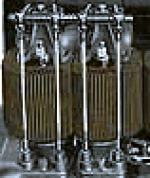
|
| Chevrolet illustration of paired cylinders and valve gear |
Kettering was keenly aware of the problems oil leaks posed in an air-cooled design. If oil leaked onto the hot cylinders, it would at least produce a smoky smell, and at worst could result in fire hazard or impaired cylinder cooling because of the resulting varnish layer. He designed his engine so that only one seam could leak oil onto the hot cylinders--the joint between cylinder and crankcase. There was no oil above the cylinders, so no place to leak.
It was at about this stage that he made a presentation on the engine to the GM Executive Committee focusing on the four-cylinder version for economy cars meant to compete with the Model T. The committee, especially GM President Pierre du Pont, was impressed with both the possibility of eliminating the radiator and its problems (remember--no antifreeze in 1919) and with the progress Kettering had made.
In 1920, du Pont decided to buy DELCO along with a consortium of other automotive suppliers (New Process bearing, Hyatt Bearing, Harrison radiator, Remy electrical, and Perlman rim) and offered Kettering a generous sum and a job as a research scientist with GM in return for his part of the company. Kettering accepted and Du Pont founded the General Motors Research Corporation, appointing him Chief of Research.
After he started working for GM he considered the cooling fan. Kettering adopted the opposite of the Corvair system: Cooling air was drawn from the bottom of the cylinders up to the top and over the heads by a stamped aluminum centrifugal belt-driven fan at the front of the engine turning at 1.5 times engine speed. As in the Corvair, the belt design posed some problems, and Kettering advanced the art some before he found a solution. He chose cooling by suction fan because it was quieter and because airflow over the engine was easier to control. Further, the natural pattern of airflow over the engine was bottom to top, and the draft helped engine cooling at low speeds. Bottom-end lubrication was supplied by a groove in the flywheel, which carried oil up to a gravity-feed well from which the main bearings were supplied. Everything else was splash lubricated.
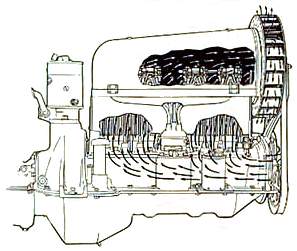
|
| Chevrolet illustration of cooling air flow over Copper-Cooled engine. Note vertical starter orientation (above flywheel). |
The engine was, of course, fitted with Kettering's own electric starter of a novel design, and a separate generator which ran from and tensioned the fan belt.
Having designed the engine, he designed a car for it. The car had fairly conventional components for easy parts availability. He also designed a larger inline six at management behest. A new, more powerful engine was needed for Oakland and an enlarged air-cooled engine seemed ideal. Most of the testing was done on the four-cylinder, though, because the tooling was nearly complete.
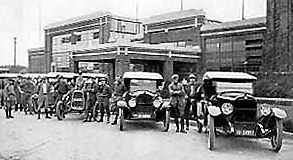
|
| Caravan of pre-release test Copper Cooled cars and support vehicles. |
Prototypes were built and testing began. The scientists and engineers used the cars for camping trips, impromptu races over public roads (which were either mud or rutted dirt at the time), and general wear and tear--all within about 100 miles of the Dayton laboratory. It was probably the most thoroughly tested preproduction car up to that time, but it was also a great departure from convention.
After months of testing he declared it ready for production in May of 1921 and turned it over to GM. GM desperately wanted a new cheap car to compete with the Model T, and the executive committee had been hoping that Kettering's design would do the trick. But Chevrolet's manager was cautious, while Oakland's engineers and management seemed much more receptive to the air-cooled idea. The six-cylinder prototype was sent to Oakland to be examined and tooled for production--the first time it was tested by anyone outside of Kettering's Research Corporation. GM management set a timetable for the stoppage of production of water-cooled models at Oakland and Chevrolet and the start of Kettering's design.
The Oakland production engineers didn't like the new car from Kettering or the roughshod way in which it was being pushed on them by corporate management. Chevrolet and Oakland had both been designing their own new cars and didn't appreciate them being casually dismissed in favor of an untried, unorthodox new car about which they had no say. Chevrolet and Oakland had both belonged to GM for only about ten years at that time and still regarded themselves as autonomous companies which just happened to be part of the General. GM executive Alfred Sloan describes the result in his Autobiography:
There was a pause, and then shock. Word came that the car had failed its tests at the Oakland division.
On November 8, 1921, Mr. Hannum [general manager of Oakland] wrote to Mr. du Pont:
With the changes that are necessary to make this a real job, it is going to be impossible to get into production in the time specified, in fact, to get this car to the point where, after all tests are complete and we are ready to put our O. K. on same, it will take at least six months.
To bridge the time when the present allotment of the old models are completed, which will be about Dec. 15th, and the time we bring in the new Air Cooled Car, we are planning on bringing in a complete new [water-cooled] line...
I want to say further the changes which we have in mind for the Air Cooled Job have not changed my views of the proposition in the least, as I believe, when we get the first job on the road, with the changes incorporated, there will be a great change in the test reports.
Kettering was angered that anyone could find a flaw in the car he had spent so much time, effort and money on. He was certain it was superior, and took any criticism of the car personally. Management appeased him, and encouraged its further development for production while simultaneously ordering continued water pumper design work at the divisions. They set the timetable back to getting the Chevrolet four in production by September, 1922 and sent staff engineers from Chevrolet and Oakland to coordinate with Kettering's staff at the Research Corporation. Spring came. Kettering observed that Chevrolet and Oakland were dragging their feet on the changeover. Reports through summer and fall from Chevrolet were favorable about production by the new year. Oakland lagged behind.
At about this time William S. Knudsen became Chevrolet's division manager. The previous manager had been indifferent about the car and uncomfortable with the corporate politics surrounding it. Knudsen thought that the air-cooled engine wasn't up to daily use and abuse in a car and told Kettering so. No wonder Kettering thought Chevrolet was uncooperative.
Kettering began soliciting support for his car among other GM divisions, found the head engineer of Oldsmobile receptive and reported this in May to the corporate executive committee. Nothing continued to happen until November, 1922 when Kettering put an ultimatum to the Executive Committee: Either order production or abandon it completely. The Executive Committee reassigned first priority for the engine to Olds with Chevrolet to build theirs after the concept was proven in the six. Oakland was indefinitely shelved.
Along came 1923. At the New York Automobile Show in January the Copper Cooled (du Pont had named it to differentiate from other air-cooled cars) Chevrolet chassis was shown as a concept car. It was the hit of the show. In production form the four cylinder engine had a bore and stroke of 3.5 inches and displaced 134.7 cubic inches--a little smaller than the 1960 Corvair. Maximum output was 22 horsepower at a brisk 1750 rpm--Kettering had purposely restricted the intake ports to limit the engine's power and speed capabilities and increase durability.
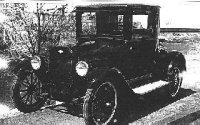
|
| Undated photo of Copper Cooled Chevrolet. |
After the highly successful showing, Copper-Cooled Chevrolets where hurried into production, supposedly to gradually increase to 50,000 cars per month by October. Production of water-cooled Chevys was to continue until the Executive committee stopped it. It quickly became clear however, that Chevrolet would not meet the production goals.
Chevrolet had problems mass-producing the Copper Cooled car--many parts were unique to it and were of novel design. And when they did get it correctly assembled, it wasn't polished enough to call it a production car. The few that made it to the field proved to have major problems, and the idea of replacing water pumpers was quickly dropped. Meanwhile sales of all cars were booming, and Chevrolet sold a record number of the obsolete water-pumper that year. The Executive Committee decided to settle the issue of the six-cylinder copper-cooled engine once and for all. They appointed a committee of three chief engineers from three divisions (Chevrolet, Northway, and Buick) to report on the status of the project. The engineers found:
That the [copper-cooled "6"] engine pre-ignites badly after driving at moderate speeds in air temperatures from sixty to seventy degrees. That it shows a serious loss of compression and power when hot, though the power is satisfactory when the engine is warming up from the cold condition.
These major difficulties plus several minor ones which can be reported in detail, if you so desire, lead us to the conclusion that the job is not in shape for immediate production. We recommend that we set it aside for further development and it be left out of consideration as far as immediate production is concerned.
About then Pierre du Pont decided that he had had enough of the car business and decided to step down from the presidency of GM. Alfred Sloan replaced him. Du Pont had been thoroughly in favor of the copper-cooled project; Sloan, an accountant by training, was indifferent to it and worried about the management problems it caused.
The Executive Committee canceled the Olds copper-cooled program and directed the division to proceed with a new water pumper design which would work with the copper-cooled chassis. The copper-cooled six was assigned to the Northway division for further development.
GM now began damage-control: A total of 759 Copper-Cooled Chevrolets were produced; 239 were scrapped before leaving the factory. Five hundred had been delivered to the sales organization, 150 of those were used by factory representatives. Three hundred had been sold to dealers, and a hundred of these had made it to customers. In June, 1923 the Chevrolet Division recalled all copper-cooled cars from the field.
Kettering decided (correctly) that GM would never produce his car again. He proposed to the Executive Committee that he be allowed to take himself and his engine out of GM.
Sloan writes:
My problem was to reconcile Mr. Kettering's natural reactions and enthusiasm for his new idea with the realities in the case. The copper-cooled car had failed to meet the test of validity. It had failed at Oakland. It had been adjudged as needing further development by a joint study made by the chief engineers of Buick, Chevrolet, and Northway--a highly competent group. Sample cars produced by Chevrolet and sent into the field had been withdrawn because of various defects. The problem was complicated by the uncertainties of a new chassis as well as a new engine. We had to recognize that research engineers had little experience, relatively speaking, in chassis design as compared with the engineering staffs of the operating divisions. I had of necessity to respect all these facts and circumstances.
It was finally agreed that any copper-cooled car production would be done by the Research Corporation as a pilot project, and the whole thing would be brought up for consideration again when all the bugs were out. Kettering stayed on with GM Research Corporation and came up with a lot of good ideas in the following years: tetraethyl lead as an antiknock fuel additive, high compression engines, nontoxic refrigerants (Freon), two-cycle diesel engines, and so on. But GM did not produce another air-cooled car until the Corvair almost 40 years later.
Sloan regarded the whole issue as a valuable, if expensive, lesson for GM. It pointed out the importance of having defined responsibilities for all parts of the corporation, including management. Sloan regarded the Copper-Cooled Chevrolet as an organizational, not an engineering failure.
Corporate politics aside, it is clear that Kettering was working with incomplete knowledge of heat flow in his engine. The cooling system drew hot air over the manifold and rocker assembly, ensuring that the intake manifold would heat quickly. Further, the intake was an integral casting with the exhaust manifold, and so a lot of heat was carried over that way, preheating the mixture as the engine warmed. This would both encourage detonation and lead to the loss of power cited by the testers. Another likely cause of detonation was the choice of cast iron as the cylinder and cylinder head material. Iron is a poor conductor of heat, and from the center of the combustion chamber to the nearest finned surface was about 11/4 inches. Under a hot, high-load situation the exhaust side of the chamber probably started glowing, and caused preignition. There is also the very real possibility of cylinder bore distortion as the engine heated, which might cause the "serious loss of compression and power when hot."
Another factor was that the testers were familiar with side-valve engines with water cooling. When one of these starts to run hot and detonate, you slow down to allow more time for the pressure rise in the combustion chamber to occur and to allow the chamber to cold-soak with circulating water. Doing the same thing with a hot air-cooled overhead-valve engine will result in more detonation, because the cooling fan is pumping less air over the already hot engine, the fuel mixture has more time to heat before it is ignited, and because of the greater tendency of overhead-valve engines to detonate at lower running speeds. Kettering probably never experienced these problems because he was testing his car too hard. If he had driven it more in downtown Dayton on hot summer days he might have discovered and fixed the design problems before anyone else ever tested the prototype.
Lastly, the engines were poorly assembled at the Chevrolet factory. The complex manifold-port casting usually had some residual core-sand in it when it was machined and assembled to the engine. It doesn't take much sand to ruin the cylinder bores and contribute to the performance problems cited by Chevrolet in their decision to recall the design.
The actual customer complaints cited were various: First was noise, which turned out to be cause by the camshaft design. A quieter one was designed and would've been used had production continued. Excessive clutch wear was another common complaint--but the two-plate dry clutch had been designed by Chevrolet engineers, not Kettering. Shoddy work, excessive cylinder wear, carburetor problems, and fanbelt problems made up the majority of the remainder of complaints--all were either not Kettering's design (the carburetor), or were caused by improper assembly or repair.
The parallels to the Corvair are interesting--we are lucky that it was Chevrolet's chief Ed Cole who pushed the air-cooled design in the fifties, or there might very well have been the same problems with corporate politics again. It also appears that fanbelt problems in design and use are just a feature of air-cooled Chevrolets.
If you want to see a Copper-Cooled Chevy today, there aren't many to find. Unfortunately, Chevrolet's recall campaign was extremely effective. The easiest one to locate is a utility coupe on display (ironically) at the Henry Ford Museum in Dearborn, Michigan. The last reported location of the other one was the Harrah automotive collection (now the National Automotive Museum, Reno, Nevada)
Several engines saved from the mass-scrapping were used in low-power industrial applications for years at GM factories and eventually found their way into the hands of collectors. This handful of cars and engines is all that remains of the Corvair's closest ancestor.
Photo sources:
- http://www.duboismarketing.com/ket.html
- Nor-West Farmer, 20 May 1922. Ad for Delco-Light. Provincial Archives of Manitoba, Still Images Section. Newspapers Collection. Item Number 2. Negative 5212. http://timelinks.merlin.mb.ca/imageref/ref0457.htm
- The Saga of the Copper-Cooled Chevy http://www.rideanddrive.com/copper-cooled.html
- http://id.mind.net/~peterson/delco.jpg
- http://www.acdelco.com/parts/l1145_00.htm
copyright © 1998 Rad Davis; all rights reserved